Mimulus: description and varieties, planting and care

Unique flowers of mimulus occupy a special place among garden plants. They are valued not only for their bright and extraordinary colors, but also for the special shape of the buds, which resembles a monkey's face. In this material, you will get acquainted with the description of the mimulus flower, popular varieties, as well as the intricacies of planting and caring for this plant.


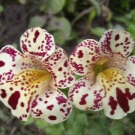

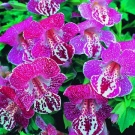

Peculiarities
Mimulus (or lipstick) is a semi-shrub herb from the Frim family, which is distinguished by the spotty and bright color of its buds. The habitat of the flower in its natural environment is zones with a temperate or monsoon climate. On the territory of Russia, this plant is not used very often in landscape design, but in North Africa and New Zealand it is grown everywhere.
The plant is cultivated exclusively for decorative purposes and is used to decorate flower beds, terraces, paths, borders and loggias.


Types and varieties
Today, gardeners have managed to breed about 150 independent varieties of mimulus, but only 2 types are usually used to decorate garden plots: red and yellow lipstick. You should familiarize yourself with the external characteristics of these species in more detail.
Red
This type of lipstick is also called purple - such flowers have drooping stems with rich red or purple buds and ovoid leaves with bulging veins. This is a fairly tall plant with long pedicels. Among Russian gardeners, the following varieties of red lipstick are most often grown: Auranticus, Cardinal, Rose Queen and Red Dragon.


Yellow
This variety came to Russia from Chile. Such flowers have high pubescent shoots up to 60 cm in height. Characteristic differences of the species: bright yellow buds with a yellowish fluff, as well as a special form of leaves with teeth at the edges.
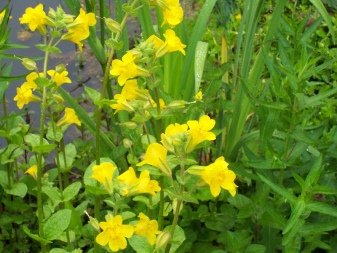

Other
There are also less common varieties of mimulus.
- Orange - a fairly tall plant with emerald, shiny foliage and pale orange buds. It is considered perennial, but it is recommended to store it indoors during the winter.
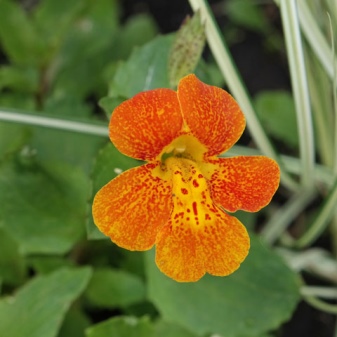

- Pomegranate. A very common variety in California. Differs in bright burgundy flowers with a yellowish heart-shaped.


- Mottled. This flower can be found in the USA and New Zealand. It is characterized by small lemon-colored buds with a reddish speck in the core, as well as high shoots up to 80 cm. Among the most famous varieties are Richard Bish.


- Copper red. Not particularly tall plants with bare reddish stems and copper-red buds on short axillary pedicels. At the end of flowering, the flowers acquire a delicate golden canary hue. The most popular varieties: Red Imperor, Andean Nymph, Rother Kaiser.
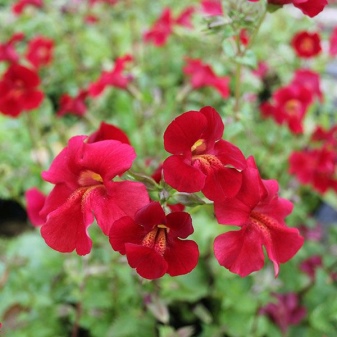

- Primrose. One of the lowest lipsticks (up to 15 cm in height), which is distinguished by thin shoots and oblong leaves. The buds of this species are lemon with a red dotted speck. This is the only frost-resistant species among the Mimulus.


- Musky. A very recognizable plant that is characterized by lemon flowers and large teardrop-shaped leaves covered with pile. In addition, this plant emits a strong musk scent. These flowers usually do not grow taller than 30 cm.

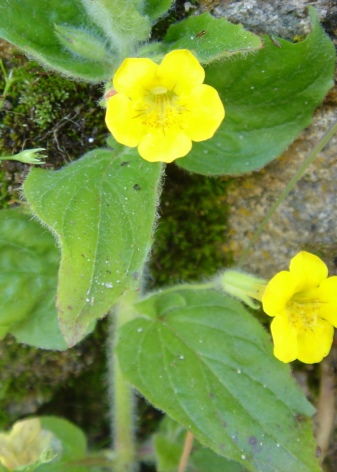
- Disclosed. This variety has small pinkish or pastel lilac buds, as well as narrow elongated green leaves.

- Brindle (also known as Hybrid, Leopard and Maximus). These plants have a relatively small height (up to 25 cm) and differ from other species in multi-colored buds interspersed with brown, burgundy and crimson flowers. Includes many varieties, including "Viva", "Winter Sunset", "Vaudeville" (mix of varieties), "Magic", "Foyer King", "Twinkle Mix", "Brass Monkeys" and others.


Sowing seeds for seedlings
Lipstick seedlings can be purchased at gardening stores or grown on their own. If you want to grow Mimulus seedlings from seeds, you need to follow the instructions below.
- You can collect planting material after the flower has bloomed, when the box fruits are fully ripe. Also, seeds can be purchased at the store.
- You need to plant seeds no later than the first half of April, but some varieties with an early flowering period can be sown as early as late February.
- For planting mimulus seeds at home, it is better to choose a nutritious, neutral or slightly acidic soil (up to 5.8 acidity levels). A universal soil for garden plants is also suitable here, but you will need to add humus, peat and sand to it. Ideally, the substrate for planting sponge seeds should include turf, leafy soil, peat, sand and humus in a ratio of 1: 2: 1: 1: 3.
- For planting seeds, it is best to use wooden or polymer boxes, but always with holes to drain moisture. Small plastic cups or ceramic pots are also good options.
- First, high-quality drainage from gravel or broken bricks is placed in the containers, then the soil is carefully placed, which is loosened and moistened with a sprayer.
- Lipstick seeds are very small, so you need to handle them with a toothpick. Try to distribute the planting material evenly throughout the container, keeping a minimum distance of 2-3 cm between the seeds. It is not necessary to deepen the seeds much; it is enough to press them down a little.


Further seed care also includes a number of specific activities.
- After planting the seeds, the soil in the containers is again sprayed with a spray gun, then the containers are installed in a warm place (with a temperature of at least 18 degrees) and covered with foil or glass.
- It is very important to control the frequency of watering, to prevent the soil from drying out or waterlogging. In some cases, mold appears under the film on the ground - this is a sign that it is sometimes necessary to air the container.
- As soon as the first sprouts appear, the seedlings are set in a cooler room with good lighting. Ideally, the temperature should not drop below 10 degrees, humidity should not be more than 80%.
- If there is not enough lighting in the room or it is regularly cloudy outside, special lamps are installed above the seedlings.
- Approximately 7-8 days after the emergence of sprouts, the soil in the containers is fertilized with complex fertilizing with nitrogen and potassium. The next feeding is carried out with an interval of 10-12 days.
- As soon as the sprouts have 3 healthy petals, they are transplanted into separate containers - peat pots or paper cups with a volume of at least 150 ml are best suited here. Up to 3-4 seedlings can be placed in each such container.
The seedlings are waiting for planting until May, after which the standard procedure for planting a lipstick is followed, which you can familiarize yourself with below.


Landing in open ground
Usually Mimulus is planted in open ground in the form of strong seedlings with several leaves or transplanted from pots purchased in gardening stores. but in southern warm regions, it is allowed to plant a sponge on the site and in the form of seeds.
The seed growing method is used in the cultivation of certain varieties of Mimulus and does not guarantee the preservation of the varietal qualities of the plant.

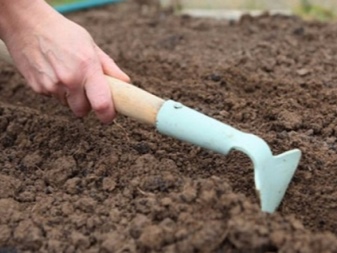
Optimal timing
The best time for planting Mimulus seedlings in the ground can be considered the end of May or the beginning of June - during these months the earth will already warm up enough, but it is still saturated with enough moisture for the plant to take root.
The timing of planting also depends on the region where the lipstick will be planted: for the southern regions with a warm spring, the mimulus is planted at the end of April, but in the northern territories, such as the Urals or Siberia, the landing is shifted to the second half of June. In any case, you need to ensure that the external temperature during disembarkation does not fall below 15 degrees.

Instructions
Brief instructions for disembarking Mimulus in the form of seedlings and seeds look like this:
- the ideal time for planting Mimulus seedlings is mid-May or early days of June;
- healthy and strong plants from 6 weeks of age are selected for seedlings;
- before planting the plants, the soil is prepared - the lipstick feels best on fertile, loose and light soils containing humus and peat;
- when choosing a place, focus on areas in partial shade so that the sun hits the plants only in the morning and evening, but not at noon (direct sunlight can burn the plant, make its leaves sluggish and reduce the color saturation of the buds);
- it is not recommended to plant these flowering plants next to shrubs or trees with superficial root shoots - near them the lipstick will regularly lack moisture and vitamins from the soil;
- seedlings are placed in shallow (up to 10 cm), but wide holes with a small distance between specimens of 15-20 cm, over time, mimulus bushes can grow and interfere with each other.
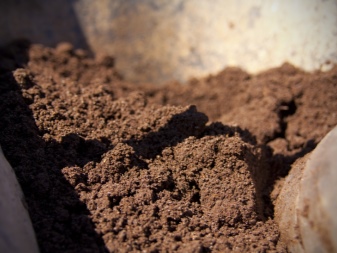

Mimulus seeds are rarely planted in open ground - most of the planting material is destroyed and loses varietal qualities... In addition, when planting seeds at the same time as when planting seedlings, the flowering of such flowers will begin much later - in the fall or at the end of summer.
It is better to plant seeds in early June at an external temperature of at least 15 degrees. During planting, they are evenly distributed over the site and placed in the soil at a shallow depth, then covered with a dense film. Once most of the seedlings have emerged, they will need to be thinned out a little.
Picking and planting of seedlings to a permanent place is carried out not earlier than the appearance of 2-3 full-fledged leaves on the sprout.



How to take care of it properly?
Gubastik, regardless of its variety and variety, can hardly be called a picky plant to care for. In general, all caring for this flower comes down to regular watering and feeding - these procedures directly affect the abundance and color saturation of mimulus buds.
Watering
Regular watering and a consistently high level of humidity are the key to a beautiful, strong and healthy mimulus. Ideally, this plant should be watered daily, especially during the summer season. Keep in mind that the near-stem circle near the plant should always be slightly moistened - for this, a layer of mulch is usually organized near the lipstick. Despite the fact that Mimulus is very fond of moisture, you should not overdo it with the amount of water for 1 watering. Excessive moisture can lead to rotting of the roots, the formation of a fungus on the lipstick bush, as well as the appearance of snails and slugs - the main pests of this flower.
For watering mimulus, lukewarm, but settled water should be used. Watering itself is done in the morning or evening. The moisture in the root circle near the flower will dry out quickly from the sun's rays and can burn its leaves. The lack of moisture in the roots of the plant will be indicated by the general sluggish appearance of the bush and the lack of flowering, the excess amount of moisture can be guessed by the small holes on the leaf plates.

Top dressing
Regular feeding is mandatory to strengthen the immunity of the lipstick and the saturation of the color of its buds. Usually, it is mineral fertilizers with potassium, phosphorus and nitrogen that are chosen for these plants. The very first feeding is carried out already 3 weeks after planting a young plant in open ground. After that, top dressing should be carried out at least 1 time per month.
Usually, a solution of 15 ml of a mineral preparation and 10 liters of water is used to feed Mimulus. You should not overdo it with the percentage of nitrogen in fertilizers - it will lead to the formation of a large number of shoots and greenery, increase the height of the plant, but reduce the number of inflorescences. Additional feeding of the lipstick is recommended during periods of active growth, after pruning, and also if the plant is sick.
For the appearance of the first flowers or more abundant flowering, a solution of magnesium sulfate (20 grams) is used for 10 liters of settled water.



Loosening and mulching
Professional gardeners recommend loosening the mimulus in the near-stem circle after each watering - this is necessary so that the moisture is absorbed into the soil faster and reaches the roots. In addition, loosening allows you to remove weeds that can interfere with flower growth. You should not overdo it with the depth and thoroughness of loosening - the lipstick has a superficial root growth that is easy to damage. As for mulching, it is carried out not only to retain moisture near the roots of the plant, but also blocks the growth of weeds, and also provides passive fertilization of the soil after each watering.
Depending on the variety of sponges, the following materials can act as mulch: needles, fallen leaves, humus, peat, straw and sawdust. The layer of mulch is selected based on the type of soil on the site - for loam it should be no more than 2-3 cm, on sandy loam soils - up to 6 cm.Try to lay out the layer of mulch so as not to touch the trunk of the plant.



Wintering
Some gardeners grow the lipstick as a perennial, but wintering the plant in outdoor conditions is impossible - everything is explained by the warm homeland of this flower and its inability to lingering frosts. Already in the fall, after the end of the flowering period of the mimulus, its bush is cut shortly, then dug out together with an earthen lump and transplanted into a small container. It is best to store a container with a flower on a windowsill or put it on a loggia.
Transplanting back to open ground is carried out only in the spring, after the soil has thoroughly warmed up and all the snow has melted.


Diseases and pests
Usually, the varieties of sponges are distinguished by a very strong immunity to many fungal and viral diseases, however, if the conditions for growing these flowers are not followed, some diseases and pests can cause significant harm to them. Below will be described the main diseases and pests that gardeners have to deal with when growing mimulus in a garden plot, as well as effective ways to combat them.
- Blackleg. This fungal disease very often affects garden crops and is usually observed precisely on seedlings and young bushes of flowers. Typical signs: rotting and blackening of the stems and basal neck, weakening and wilting of the bush. To combat this disease, the diseased plant is isolated from other crops, the amount of watering is reduced, all infected plant areas are treated with potassium permanganate (5 grams per 1 liter) or wood ash. As a preventive measure, the plant is treated with fungicides (Fitosporin, Baktofit, Etin).
- Gray rot. Another fungal disease, expressed in characteristic gray spots on the leaf plates and stems of the mimulus, in addition, a characteristic fluff can be seen on the spots.To cure the plant in this case, all the affected areas are removed, the plant is separated from the rest and treated with Bordeaux mixture or poisonous drugs like Champion or Oxychoma. If the infection has just begun to spread, all infected areas are treated with a mixture of ash (250 mg), chalk (250 mg), copper sulfate (1 tsp), then everything is mixed with 10 liters of water. This mixture should be enough to process 2-3 square meters of land.
- Snails and slugs. These pests appear at high levels of humidity and leave large holes and traces of mucus on the leaf plates of flowers. Slugs can be collected by hand, or you can place beer traps near the mimulus bush. Chemicals can be used to radically combat these pests, but they are highly toxic to other plants and pets.
- Powdery mildew. Also a fungal disease, which can be easily recognized by the white bloom on the leaves of the plant, which at first can be confused with dew. In the fight against the disease, the destruction of the affected areas and the treatment of the diseased plant with fungicides helps.
- Aphid. Distinctive signs of the appearance of aphids on a plant: twisted leaf plates, the appearance of ants, wilting and yellowing of the leaf plates of a flower. After all, aphids always infect plants in whole colonies, so it's hard not to notice them. Insecticides in the form of "Intavim", "Neorona" or "Confidor" help in the fight against these pests. You can also try to collect aphids from the plant by hand.
Very rarely, but mimulus becomes a place for whiteflies - these pests can be recognized by a shiny white bloom and by caterpillars on leaf plates. Conventional insecticides are used to combat.



Use in landscape design
- Due to the great affection of the lipstick to high humidity, it is often used to decorate decorative ponds.

- If we talk about growing this flower indoors (as an element of the interior of summer arbors or loggias), then here it looks harmoniously with lobelia or verbena. The combination of lipstick and matthiola is especially interesting - the joint aroma from these plants will drive even the most seasoned gardeners crazy.


- If we talk about planting a mimulus in open ground, then here it looks best in tandem with a funky, a sitovnik or a false spirea. Gubastic can be successfully planted in flower beds with other plants or grown separately from other flowers. Many gardeners plant several varieties of mimulus in the garden at once to create colorful, bright and eye-catching flower beds.



- Very often mimulus is used in the design of the so-called rock gardens, where it is combined with ivy, buttercups, garden viola or wild dill.


The frequency of using mimulus in garden design is explained by the low requirements for caring for this plant - even novice gardeners can grow it. This flowering plant is able to decorate any suburban area with bright flowers from the beginning of summer until the very beginning of frost.
For information on how to sow Mimulus correctly, see the next video.







































































































The comment was sent successfully.